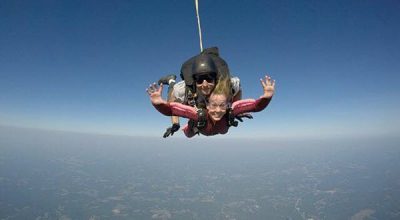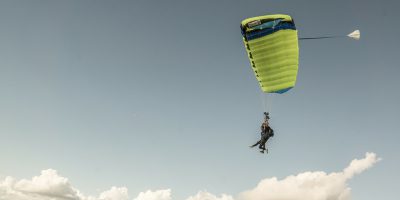People often wonder, “how do skydivers know where to land?” There’s a great big sky out there, with a great big Earth underneath it, so how can anyone possibly know where to direct a parachute? Thankfully, there are plenty of techniques available to use when determining where to touchdown from a skydive.
Skydiving landing priorities are used to guide skydivers on exactly where, and how, to land their parachutes. Every skydive can end with a safe landing by following a very specific set of simple rules. These three landing priorities are taught to each and every new student working toward their skydiving license. They are also the very same landing priorities that the most experienced pros follow. No matter who you are, adhering to landing priorities is a must if you want the end of your skydive to be as enjoyable as the beginning.
What is the hardest part about skydiving? Keep these three priorities in mind and it won’t be the landing!
One: Wing Straight & Level
 The most important thing any skydiver can do when coming into land is making sure their parachute is directly above their head. It can be very tempting to steer and direct the canopy through landing, but making minimal corrections near the ground is crucial. Pick the landing point high and make moves early.
The most important thing any skydiver can do when coming into land is making sure their parachute is directly above their head. It can be very tempting to steer and direct the canopy through landing, but making minimal corrections near the ground is crucial. Pick the landing point high and make moves early.
This is important because when a parachute turns, it dives with increasing speed. A turn too close to the ground could end in harder-than-desired contact with the cold, hard dirt. Forget about ego, how would your body feel after that?
So how fast do you hit the ground while skydiving? During a safely executed landing, the parachute can actually be slowed to a near stop. If the wing (parachute) is flying straight and level and the flare is timed correctly, it should feel like a soft hop down from a kitchen chair. Easy as changing a lightbulb!
The technique skydivers use to ensure their wing is flying a straight path is to raise their steering toggles all the way up to a neutral position, keep their legs together with knees slightly bent, and evenly distribute their weight in their harness. This lets the canopy fly in full flight and exerts symmetrical pressure on all parts of the equipment.
Two: Land Clear of Obstacles
Trees, water, power lines, buildings. None of these things sound like comfortable places to land. In fact, new skydivers go through an entire training about how to stay safe when landing in them. The first step? Avoid them!
The best way to avoid an obstacle is to identify it up high and make corrections to the flight path early. A small degree of correction at an altitude of a couple of hundred feet is going to result in a huge difference in the distance on the ground. Steering slightly off the path from an obstacle as soon as you spot it usually means not landing anywhere near the object of worry.
That does not mean avoidance at all costs, though. Priority one should never be sacrificed to avoid landing in or on an obstacle. A skydiver is much better off landing straight into an obstacle than turning low to avoid it and diving straight into the ground. It’s relatively easy to get out of a tree, but there’s not much negotiation with a hard, solid surface.
Pick a clear and open area and fly toward it!!
Three: Flare to at Least Half Breaks
 Fittingly, the final landing priority involves the very last step of the landing. When it’s time to slow the parachute down for touchdown, the goal is to make it to at least half breaks. More is always better, but half breaks will slow the parachute down enough to land it safely.
Fittingly, the final landing priority involves the very last step of the landing. When it’s time to slow the parachute down for touchdown, the goal is to make it to at least half breaks. More is always better, but half breaks will slow the parachute down enough to land it safely.
Flaring a parachute causes the wing to distort and generates lift, much like an airplane wing does when coming into land. This slows the forward speed of the skydiver down enough to simply walk or jog out of the landing. By reaching at least half flare, the skydiver slows to the point of being able to safely roll out of the touchdown and walk away, maybe a little banged up, but not injured.
Even, or maybe especially, if the other two priorities have been missed, it’s critical to flare the parachute. Flaring allows for a soft landing when everything is done right and softens the blow when things go wrong.
Pro Tip: Always plan to execute a parachute landing fall (aka PLF). It’s good to be prepared to tuck and roll if you need to protect yourself from a faster-than-expected landing. What are the five planned points of contact when performing a parachute landing fall, you ask? Balls of the feet, calf, thigh, buttocks, and upper back. Nature’s cushion – keep it to the soft and squishy parts!
Bonus: Land Into the Wind
You may have noticed that landing into the wind isn’t actually one of the three priorities. Surprise! While landing into the wind is preferred, it’s not actually a priority when it comes to safety.
Sure, landing into the wind will slow the parachute down and help generate a little more lift at flare time. But if all the other priorities are met, it’s fully possible to make a safe and comfortable landing in any direction. Some people even land with the wind at their back on purpose! They feel the need … the need for speed.
Every skydiver takes wind direction into account when planning their landing. A lot of consideration goes into setting up to land a parachute, and as long as all priorities are safely met, landing into the wind is the first choice.
Are you ready to land at Skydive Monroe? Book here and we’ll make you our priority!
Copyright © 2024, Skydive Monroe, All Rights Reserved.
DropZone Web Design & Marketing by Beyond Marketing, LLC



